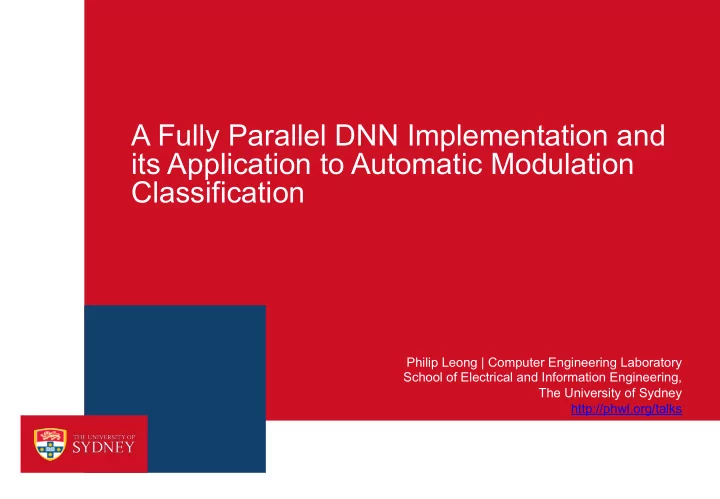

A Fully Parallel DNN Implementation and its Application to Automatic Modulation Classification Philip Leong | Computer Engineering Laboratory School of Electrical and Information Engineering, The University of Sydney http://phwl.org/talks
Computer Engineering Laboratory › Focuses on how to use parallelism to solve demanding problems - Novel architectures, applications and design techniques using VLSI, FPGA and parallel computing technology › Research - Reconfigurable computing - Machine learning - Signal processing › Collaborations - Xilinx, Intel, Exablaze - clustertech.com 2
Introduction (Stephen Tridgell PhD work) › Hard to make fully parallel implementations of a NN on contemporary FPGA due to size › Fit entire DNN on FPGA by exploiting unstructured sparsity and the following techniques: 1. Buffering of streaming inputs in a pipelined manner 2. Ternary weights implemented as pruned adder trees 3. Common subexpression elimination 4. Digit serial arithmetic for throughput matching 5. Sparsity control 6. Incremental precision throughput matching › Apply to automatic modulation classification (AMC), an integral component in intelligent radio 3
Overview Optimising CNNs Application to AMC
Overview Optimising CNNs Application to AMC
Network Studied › VGG-7 network › Ternary weights › 16-bit activations › Accept a single pixel every cycle (p=1) - W*W image takes W*W cycles 6
1. Buffering of Streaming Inputs Implement Pipelined 3x3 Convolution Input FIFO outputs the pixel each cycle to both Buffer A and the first stage of a shift register. Buffer A and Buffer B delay the output by the image width 7
2. Ternary Weights as Pruned Adder Trees › Weights are ternary - So multiplication with ±1 is either addition or subtraction - Since we have many multiplications with 0 matrix is sparse 8
3. Common Subexpression Elimination › Weights are ternary - Reduces convolution to constructing adder tree - Subexpression merged to reduce implementation 9
Improvement in using CSE 10
4. Digital Serial Arithmetic for Throughput Matching › Used 16-bit fixed point › Each layer followed by batch normalization with floating point scaling factor › Suppose that for a given layer, p pixels arrive at the same time - For p ≥ 1 have p adder trees in parallel - For p < 1 word or bit-serial adders can match input rate with hardware resources - 4-bit digit serial has 1/4 area - 1-bit bit serial has 1/16 area › Avoids idle adders 11
5. Sparsity Control › CIFAR10 dataset › Weights are compared with threshold - 0 if less than threshold, 𝑡(±1) otherwise (s is a scaling factor) › We introduce the idea of changing 𝜗 to control sparsity 12
Breakdown of Layer Sparsity 13
CIFAR10 Accuracy vs Speed (FPGA Implementations) OUR WORK 14
Overview Optimising CNNs Application to AMC
Automatic Modulation Classification › Identify modulation type from raw radio signal - A step towards general problem of interpreting RF scenes from raw signals is a fertile research problem › Reconfigurable computing an excellent solution for this problem - FPGA enable integration of radio and machine learning in single device - Latency, size, weight and power are crucial in applications
Implementation › System implemented on ZCU111 RFSoC - 8x 12-bit 4.096GSPS ADCs - 8x 14-bit 6.554GSPS DACs - Arm Cortex-A53 - Arm Cortex-R5 › Open Source Verilog generator - https://github.com/da- steve101/twn_generator 17
FPGA Implementation › Ternary Modulation classifier: 488K class/s, 8us latency 18
6. Incremental Precision Throughput Matching Model TW-64 TW-96 TW-BA- TW- › Use incremental precision 128 INCRA- activations instead of 16 bit 128 CLBs 28k 47k 43k 42k - Adjust precision to match the (53.5%) (89.3%) (80.7%) (80.2%) throughput LUTs 124k 232k 234k 211k - Same area as ternary (29.1%) (54.7%) (55.1%) (49.6%) activations - Almost 5% accuracy gain FFs 217k 369k 333k 324k (25.5%) (43.4%) (39.2%) (38.1%) 524 524 523 512.2 BRAMs (48.5%) (48.5%) (48.4%) (48.3%) DSPs 1496 1207 1408 1407 (35%) (28.3%) (33.0%) (32.9%) Accr 78.7 81.1 75.9 80.2
Video Demonstration QAM16/8PSK/BPSK 20
O’Shea at al, RadioML Dataset 21
Conclusion › Presented an optimized network for AMC which - Applies common subexpression elimination and digit serial arithmetic to a fully unrolled ternary network - Integrates the entire design on a single chip for a low-latency batch size 1 implementation › These serve to achieve a level of performance higher than previously reported › Challenge of achieving state of the art accuracy remains › As FPGAs become larger, we believe these techniques will become more common 22
References [1] Stephen Tridgell, Martin Kumm, Martin Hardieck, David Boland, Duncan Moss, Peter Zipf, and Philip H. W. Leong. Unrolling ternary neural networks. ACM Trans. Reconfigurable Technol. Syst. , 12(4):22:1–22:23, October 2019. URL: ternary_trets19.pdf, doi:10.1145/3359983. [2] Stephen Tridgell, David Boland, Philip HW Leong, Ryan Kastner, Alireza Khodamoradi, and Siddhartha. Real-time automatic modulation classification using rfsoc. In 2020 IEEE International Parallel and Distributed Processing Symposium Workshops, IPDPSW 2020, New Orleans, LA, USA, May 18-22, 2020 , 82–89. IEEE, 2020. URL: https://doi.org/10.1109/IPDPSW50202.2020.00021, doi:10.1109 / IPDPSW50202.2020.00021. 23
Recommend
More recommend